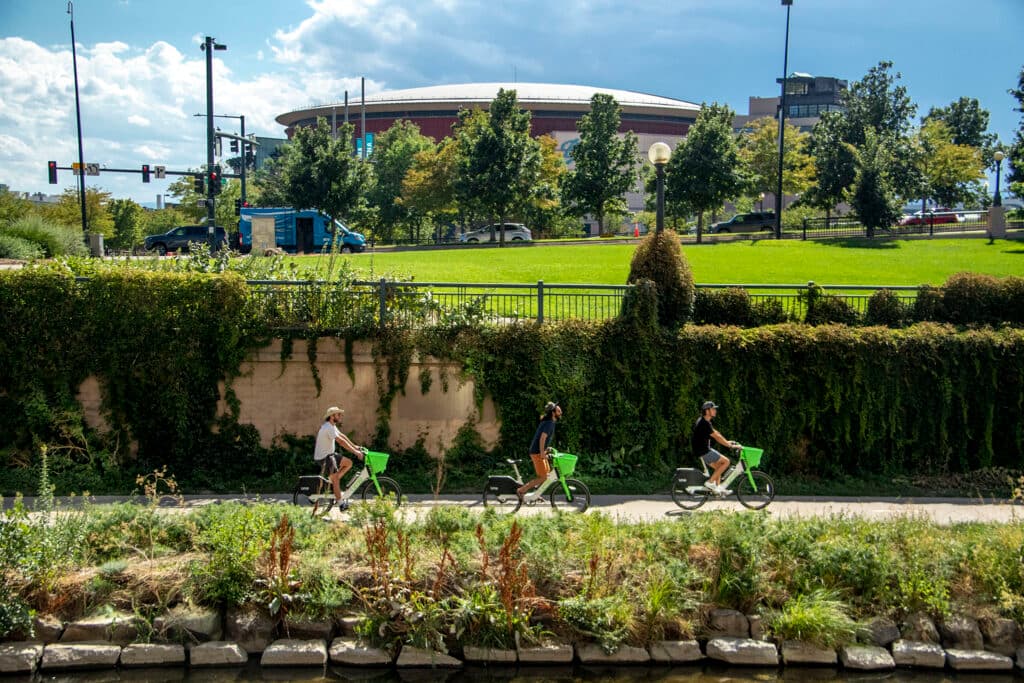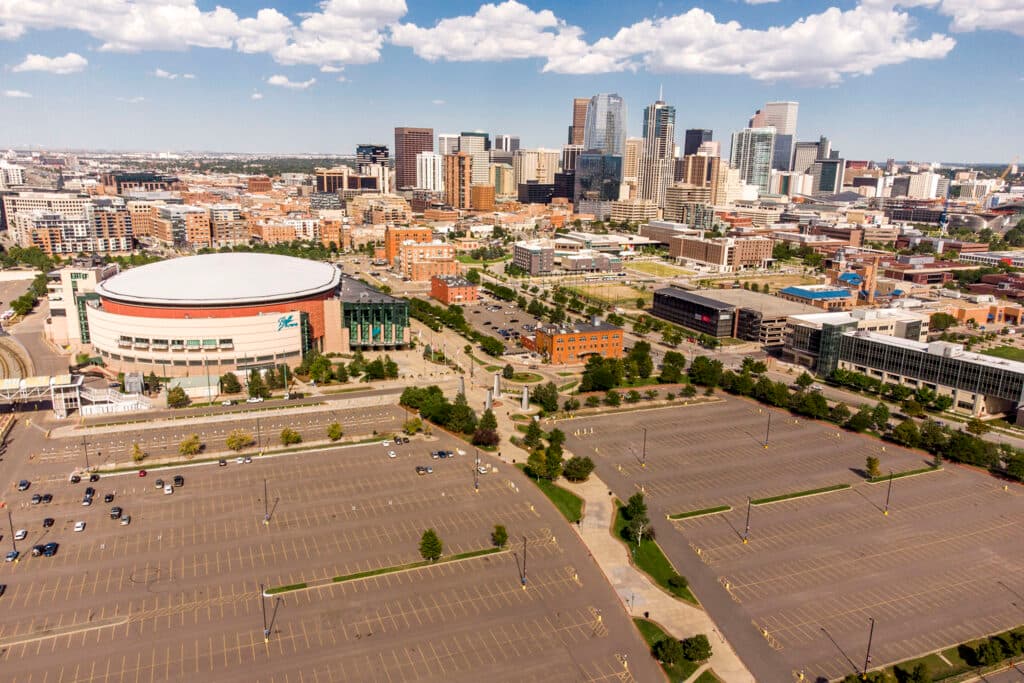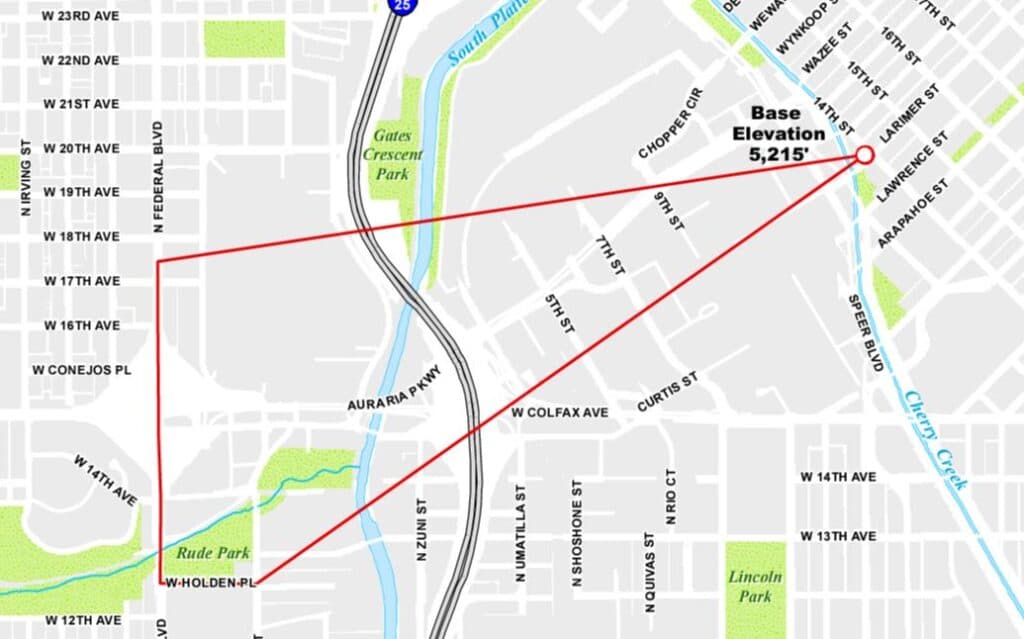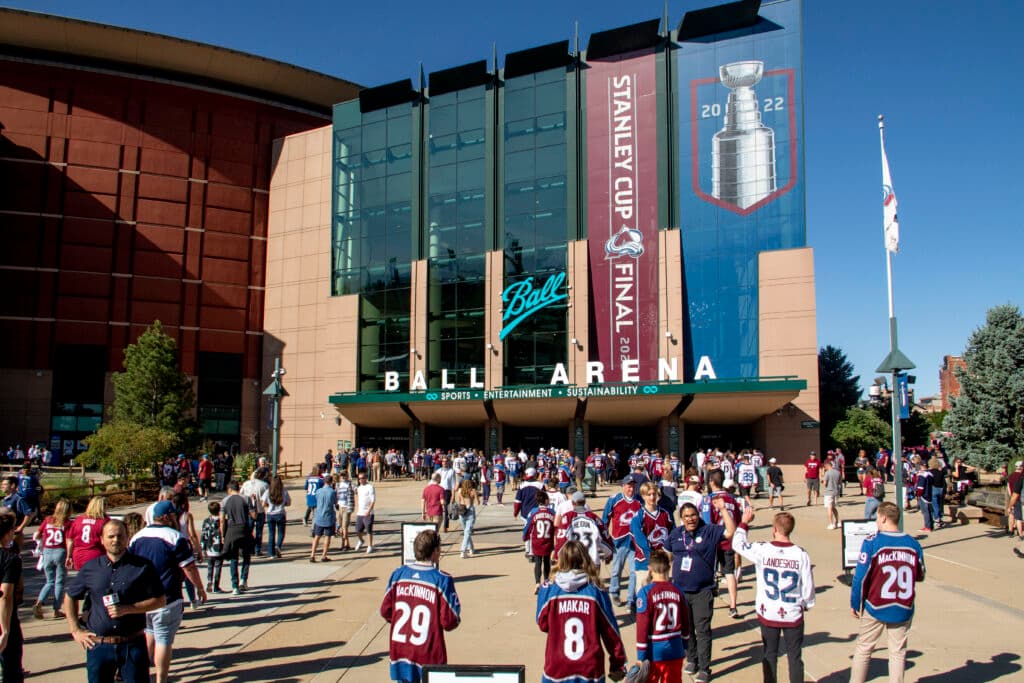The Denver City Council has approved billionaire Stan Kroenke’s plan to turn 64 acres of mostly empty Ball Arena parking lots into a development that could bring thousands of residents to an expanded downtown.
A series of largely unanimous votes, stretching late into Monday night, paved the way for a new neighborhood surrounding the home of the Denver Nuggets and Colorado Avalanche. And it’s just one part of a string of proposed developments along the South Platte River that could more than double downtown Denver’s population.
Kroenke Sports and Entertainment plans to build more than 6,000 housing units, more than 1,000 of which will be designated as affordable, on what is now a sea of pavement. Construction could begin as soon as 2026, but the development may not be finished until 2050.
The proposal authorized on Monday calls for a 5,000-seat venue, a hotel, new bike lanes, and a three-acre public park. The deal will also ensure the championship Nuggets and Avalanche stay in the immediate area until at least 2050, either at Ball Arena or in a new arena nearby.
The project earned strong support from many neighbors. After 15 months of work, numerous neighborhood and community groups signed an agreement with Kroenke. In essence, they supported the project in exchange for promises of community benefits.

The project is set to include an early childhood education center, small business support and jobs for people from lower-income parts of the city. And connections will be built to surrounding neighborhoods, from the current downtown to La Alma/Lincoln Park and Sun Valley.
The proposal drew a few complaints because its towers could block the views of some Lower Downtown residents, and it has fed into long-running worries about how fast the city has grown.
Yet the vast majority of people who spoke on Monday were in support.
“This project represents an opportunity to provide desperately needed housing,” said Ed Calahan, a resident who spoke with frustration about his many younger family members who can’t afford to stay in Denver.
Community activist Brandy Majors raised concerns the income-restricted housing wasn’t for the people who most needed it.

“This is not affordable to the average person,” she said. Of the thousand-plus income-restricted units, 50 will be for people making under 30 percent of the area median income, or $27,400 for one person.
Still, council members said the project included affordability for all.
“This project represents a critical step in addressing Denver's affordable housing, while also ensuring that we build community with affordable homes, local job creation, a park and lasting development that goes way far beyond the brick and mortar,” said Council President Amanda Sandoval, who represents District 1.

Meanwhile, District 2 Councilmember Kevin Flynn raised questions about where people from outside the neighborhood would park their cars during big events.
The answer from Matt Mahoney, a senior vice president with Kroenke, was simple: The development was people first and prioritized bikes, public transit users and pedestrians over cars. But there would also be plenty of parking garages. That answer apparently satisfied Flynn’s biggest concern.
District 4 Councilmember Diana Romero-Campbell said the project gave her hope that her kids, who can’t afford Denver, might finally have a place they are able to rent or buy.
Council rezoned the land on a 11-0 vote. The new zoning allows up to 12 stories in some parts of the development, while others won’t have a specific height limit, with the allowable height depending on how much affordable housing is included.

The details of the plan are outlined in a 134-page development agreement that also passed City Council on an 11-0 vote.
District 9 Councilmember Darrell Watson praised the developers for building a “magical community” where people could make new memories.
“You are smart enough to root it in the history of our area, ensuring, within your community benefit agreement, in your discussions, that you respected the history of the land on which you are building, while still projecting the dreams of what is to come,” he said.
Completion of the nearly 30-year project is no guarantee. Kroenke and company will have to work through economic ups and downs, securing huge amounts of financing and employing untold workers to design and then build dozens of structures — and that’s not to mention the challenges of building in the South Platte River’s floodplain.
What about the views?
Construction of the project will interfere with one of Denver’s “view planes” — a legal concept that prohibits new developments from interfering with some of Denver’s finest views. The developer proposed changing the so-called Old City Hall view plane so that they could build higher.
The idea of changing the view plane has frustrated some Lower Downtown residents, especially those living in the 31-floor condo tower at 1551 Larimer St., who have views of the mountains that could be interrupted by Kroenke’s plans.
Casey Pitinga, a Lower Downtown resident, was concerned that views from the Denver Art Museum and Colorado Convention Center would be ruined.
“The unique beauty of Denver will be compromised forever with the addition of high-rise buildings blocking the view of the mountains from various points in the city,” Pitinga said.
Council debated the value of historic view planes and whether they should be tweaked. The Old City Hall view plane was previously amended in the late 1990s to allow the buildout of Broncos’ stadium. The view has also been hampered by development on the Auraria Campus.

Changing the view planes gave Councilmember Kevin Flynn “heartburn,” he said. But the view from Bell Park, where Old City Hall once stood, is no longer there anyway, he reasoned.
From ground level, “you can’t see any mountains right now,” he said, later adding, “I will vote yes because this view plane no longer exists.”
“I’d rather lose my view than have more people in tents in District 10,” Councilmember Chris Hinds said, who has lived in condos and apartments for twenty years.
Councilmember Amanda Sawyer argued view planes preserve a right to a view. Piercing a view plane to make way for development, she said, was a precedent the council should not set. So she decided to vote “no.”
The amendment to the Old City Hall view plane passed 10-1.
Council passed three other bills related to Kroenke’s development.
Council members approved the service plan for metropolitan districts in the area — government bodies that will fund and operate everything from fire and public safety to water improvements and mosquito control.
Sawyer was concerned that the financing of a metro district would impact the affordability of the project and voted against it, as did at-large council members Sarah Parady and Serena Gonzales-Gutierrez.

The 8-3 council vote did not actually create any metropolitan districts. That will have to happen through both district court and an election. But it did pave the path for that to happen.
Sports fans will likely be most excited by a deal that extends the Nuggets and Avalanche’s current contract to stay in the city by 10 years, through the end of June 2050. That passed on an 11-0 vote.
Over the next decades, developers plan to more than double downtown Denver in size.
While the Ball Arena project is large, it’s just one part of the development plan for the South Platte. The neighboring River Mile development, which has already received its major city approvals, could add another 15,000 residents to the city center and bring dining, culture and public space to the South Platte River, including where Elitch Gardens currently sits.
For River Mile and much of the Ball Arena development to happen, the South Platte River will need to be rechanneled to avoid flooding — an enormous undertaking in its own right.
“This property between Ball Arena and River Mile,” Mahoney said, “we're very much looking at it as one holistic property.”

And that’s not the only growth the city center may soon see.
The Auraria Higher Education Campus will likely see more uses, including housing development. New construction is already rising in Sun Valley. La Alma/Lincoln Park’s Burnham Yard could be transformed from an industrial railroad property to a mixed-use development. And the Mile High Stadium District could also see even more development.
“This is going to be another downtown,” said Sandoval. “This is a catalytic project.”













